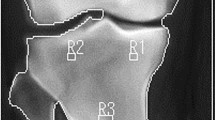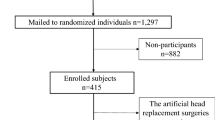Summary:
We investigated the bone metabolism of 22 patients (median age 38 years) over 6 years after allogeneic bone marrow transplantation (BMT). Biplanar roentgenograms of the thoracic and lumbar spine were used to diagnose vertebral deformities caused by fractures. The actual bone mineral density (BMD) of the lumbar spine and the femoral neck were measured. Laboratory tests included calcium, phosphate, parathyroid hormone, a marker of bone resorption (beta-crosslaps, CTX), markers of bone formation (osteocalcin, bone-specific alkaline phosphatase), osteoprotegerin (OPG) – an antagonist of the osteoclast differentiation factor RANKL, and sex hormone status. One patient had a vertebral fracture. Seven patients (28%) had osteopenia in the lumbar spine while 12 patients (48%) had osteopenia in the femoral neck. Bone resorption was increased in nine patients (43%) and bone formation was increased in four patients (20%). BMT recipients had significantly increased serum levels of OPG (P=0.029). Three women (75%) and four men (25%) were hypogonadal. The data showed that BMD is reduced and bone metabolism is still disturbed more than 6 years after BMT. The RANKL/osteoprotegerin system appears to play an important role in the pathophysiology of late post transplantation osteoporosis.
This is a preview of subscription content, access via your institution
Access options
Subscribe to this journal
Receive 12 print issues and online access
$259.00 per year
only $21.58 per issue
Buy this article
- Purchase on Springer Link
- Instant access to full article PDF
Prices may be subject to local taxes which are calculated during checkout
Similar content being viewed by others
References
Rodino MA, Shane E . Osteoporosis after organ transplantation. Am J Med 1998; 104: 459–469.
Katz IA, Epstein S . Perspectives. Post-transplantation bone disease. J Bone Miner Res 1992; 7: 123–126.
Pietschmann P, Vychytil A, Woloszczuk W, Kovarik J . Bone metabolism in patients with functioning kidney grafts: increased serum levels of osteocalcin and parathyroid hormone despite normalisation of kidney function. Nephron 1991; 59: 533–536.
Aringer M, Kiener HP, Koeller MD et al. High turnover bone disease following lung transplantation. Bone 1998; 23: 485–488.
Anonymous. Consensus development conference: prophylaxis and treatment of osteoporosis. Am J Med 1991; 90: 107–110.
Schlosberg M, Movsowitz C, Epstein S et al. The effect of cyclosporin A administration and its withdrawal on bone mineral metabolism in the rat. Endocrinology 1989; 124: 2179–2184.
Baylink DJ . Glucocorticoid-induced osteoporosis. N Engl J Med 1983; 309: 306–308.
Benker G, Schafer U, Hermanns U et al. Allogeneic bone marrow transplantation in adults: endocrine sequelae after 1–6 years. Acta Endocinol 1989; 120: 37–42.
Carlson K, Simmonsson B, Ljunghall S . Acute effects of high-dose chemotherapy followed by bone marrow transplantation on serum markers of bone metabolism. Calcif Tissue Int 1994; 55: 408–411.
Välimäki MJ, Kinnunen K, Volin L et al. A prospective study of bone loss and turnover after allogeneic bone marrow transplantation: effect of calcium supplementation with or without calcitonin. Bone Marrow Transplant 1999; 23: 355–361.
Schulte C, Beelen DW, Schaefer UW, Mann K . Bone loss in long-term survivors after transplantation of hematopoietic stem cells: a prospective study. Osteoporosis Int 2000; 11: 344–353.
Ebeling PR, Thomas DM, Erbas B et al. Mechanisms of bone loss following allogeneic and autologous hemopoietic stem cell transplantation. J Bone Miner Res 1999; 14: 342–350.
Buchs N, Helg C, Collao C et al. Allogeneic bone marrow transplantation is associated with a preferential femoral neck bone loss. Osteoporosis Int 2001; 12: 880–886.
Kananen K, Violin L, Tähtelä R et al. Post-transplant complications. Recovery of bone mass and normalization of bone turnover in long-term survivors of allogeneic bone marrow transplantation. Bone Marrow Transplant 2002; 29: 33–39.
Schimmer AD, Mah K, Bordelau L et al. Post-transplant complications. Decreased bone mineral density is common after autologous blood or marrow transplantation. Bone Marrow Transplant 2001; 28: 387–391.
Keilholz U, Max R, Scheibengoben C et al. Endocrine function and bone metabolism 5 years after autologous bone marrow/blood-derived progenitor cell transplantation. Cancer 1997; 79: 1617–1622.
Simonet WS, Lacey DL, Dunstan CR et al. Osteoprotegerin: a novel secreted protein involved in the regulation of bone density. Cell 1997; 89: 309–319.
Tsuda E, Goto M, Mochizuki S et al. Isolation of a novel cytokine from human fibroblasts that specifically inhibits osteoclastogenesis. Biochem Biophys Res Commun 1997; 234: 137–142.
Storb R, Deeg HJ, Whitehead J et al. Methotrexate and cyclosporine compared to cyclosporine alone for prophylaxis of acute graft verus host disease after marrow transplantation for leukemia. N Engl J Med 1986; 314: 729–735.
Sullivan KM, Shulman HM, Storb R et al. Chronic graft-versus-host disease in 52 patients: adverse natural course and successful treatment with combination immunosuppression. Blood 1981; 57: 267–276.
Dunn JF, Nisula BC, Rodbard D . Transport of steroid hormones: Binding of 21 endogenous steroids to both testosterone-binding globulin and corticosteroid-binding globulin in human plasma. J Clin Endocrinol Metab 1981; 53: 58–69.
Bartsch W . Interrelationships between sex hormone-binding globulin and testosterone, 5α-dihydrostestosterone and oestradiol-17β in blood of normal men. Maturitas 1980; 2: 109–118.
Vermeulen A, Verdonck L, Kaufman JM . A critical evaluation of simple methods for the stimulation of free-testosterone in serum. J Clin Endocinol Metab 1999; 84: 3666–3672.
Kanis JA, Gluer CC . An update on the diagnosis and assessment of osteoporosis with densitometry. Committee of Scientific Advisors. International Osteoporosis Foundation. Osteoporosis Int 2000; 11: 36–42.
Epstein S . Post-transplantation bone disease: the role of immunosuppressive agents and the skeleton. J Bone Miner Res 1996; 11: 1–7.
Kashyap A, Kandeel F, Yamauchi D et al. Effects of allogeneic bone marrow transplantation on recipient bone mineral density: A prospective study. Biol Blood Marrrow Transplant 2000; 6: 344–351.
Laan RFJM, Vanriel PLCM, Vandeputte LBA et al. Low-dose prednisone induces rapid reversible axial bone loss in patients with rheumatoid arthritis – a randomized, controlled study. Ann Int Med 1993; 119: 963–968.
Rizzato G, Montemurro L . Reversibility of exogenous corticosteroid-induced bone loss. Eur Repir J 1993; 6: 116–119.
Villareal DT, Civitelli R, Chines A, Avioli LV . Subclinical vitamin D deficiency in postmenopausal women with low vertebral bone mass. J Clin Endocrinol Metabol 1991; 72: 628–634.
Kerschan-Schindl K, Strametz-Juranek J, Heinze G et al. Pathogenesis of bone loss in heart transplant candidates and recipients. J Heart Lung Tranplant 2003; 22: 843–850.
Stepan JJ, Lachman M, Zverina J et al. Castrated men exhibit bone loss: effect of calcitonin treatment on biochemical indices of bone remodeling. J Clin Endocrinol Metabol 1989; 69: 523–527.
Murphy S, Khaw K, Cassidy A, Compston JE . Sex hormones and bone mineral density in elderly men. Bone and Mineral 1993; 20: 133–140.
Khosla S, Melton III LJ, Atkinson EJ et al. Relationship of serum sex steroid levels and bone turnover markers with bone mineral density in men and women: a key role for bioavailable estrogen. J Clin Endocrinol Metabol 1998; 83: 2266–2274.
Fahrleitner A, Prenner G, Kniepeiss D et al. Serum osteoprotegerin levels in patients after liver transplantation and correlation to bone turnover, bone mineral density and fracture status. Wien Klin Wochenschr 2002; 114: 717–724.
Fahrleitner A, Prenner G, Leb G et al. Serum osteoprotegerin is a major determinant of bone density development and vertebral fracture status in patients following cardiac transplantation. Bone 2003; 32: 96–106.
Vidal NOA, Brändström H, Jonsson KB, Ohlsson C . Osteoprotegerin mRNA is expressed in primary human osteoblast-like cells: down-regulation by glucocorticoids. J Endocrinol 1998; 159: 191–195.
Hofbauer LC, Riggs BL, Dunstan CR et al. Cyclosporin A and glucocorticoids inhibit osteoprotegerin production in human osteoblastic and coronary artery smooth muscle cells: potential mechanism of post-transplant osteoporosis and vascular disease. J Bone Miner Res 1999; 14 (Suppl 1): 176.
Hofbauer LC, Gori F, Riggs BL et al. Stimulation of osteoprotegerin ligand and inhibition of osteoprotegerin production by glucocorticoids in human osteoblastic lineage cells: potential paracrine mechanism of glucocorticoid-induced osteoporosis. Endocrinology 1999; 140: 4382–4389.
Schoppet M, Sattler AM, Schaefer JR et al. Increased osteoprotegerin serum levels in men with coronary artery disease. J Clin Endocrinol Metabol 2003; 66: 1024–1028.
Holzer G, Krepler P, Koschat MA et al. Bone mineral density in long-term survivors of highly malignant osteosarcoma. Oncology 2003; 85-B: 231–237.
Author information
Authors and Affiliations
Corresponding author
Rights and permissions
About this article
Cite this article
Kerschan-Schindl, K., Mitterbauer, M., Füreder, W. et al. Bone metabolism in patients more than five years after bone marrow transplantation. Bone Marrow Transplant 34, 491–496 (2004). https://doi.org/10.1038/sj.bmt.1704618
Received:
Accepted:
Published:
Issue Date:
DOI: https://doi.org/10.1038/sj.bmt.1704618
Keywords
This article is cited by
-
Low bone mineral density is associated with insulin resistance in bone marrow transplant subjects
Bone Marrow Transplantation (2009)
-
Skeletal sequelae of cancer and cancer treatment
Journal of Cancer Survivorship (2009)
-
Bone mass and microarchitecture of irradiated and bone marrow-transplanted mice: influences of the donor strain
Osteoporosis International (2009)
-
High prevalence of early-onset osteopenia/osteoporosis after allogeneic stem cell transplantation and improvement after bisphosphonate therapy
Bone Marrow Transplantation (2008)



